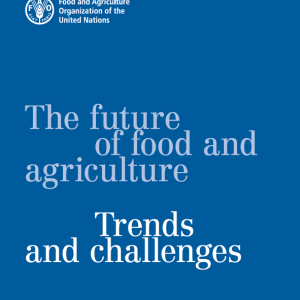
This FAO report identifies global trends and major drivers of change shaping the future of food and agriculture in the 21st century. It points to the advances that have been made within food and agriculture in the past years, analysing the current state of play and identifies a number of challenges that remain if we are to achieve FAO’s vision of a world free from hunger and malnutrition.
Their assessment of prevailing trends suggests that transformative changes in agriculture and food systems are required worldwide. The report points specifically to 10 key challenges that need to be addressed if we are to succeed in eradicating hunger and poverty, while making agriculture and food systems sustainable. Those challenges include the uneven demographic expansion that will take place in the coming decades, the threats posed by climate change, the intensification of natural disasters and upsurges in transboundary pests and diseases, and the need to adjust to major changes taking place in global food systems.
Rapid changes and transitions in food systems are described as a systemic challenge,especially as they raise concerns about the nutrient content of foods, the ecological footprint of food value-chains and the participation of smallholders in these chains. These changes call for effective national and international governance systems, as well as evidence-based and well targeted policy responses. Making food systems more efficient, inclusive and resilient are key priorities (the report notes that current food systems may well be able to produce enough food, but if they are to do so in an inclusive and sustainable manner they will require a major overhaul). More investments in agriculture and agrifood systems, including increased spending on research and development, are also needed.
To meet future demand, this report states that agriculture in 2050 will need to produce almost 50 percent more food, feed and biofuel than it did in 2012. (For a paper providing updated projections about production based on 2014 FAOSTAT data, see our summary of Agriculture in 2050: Recalibrating Targets for Sustainable Intensification). This FAO estimate takes into account recent United Nations projections indicating that the world’s population will reach 9.7 billion in 2050. In sub-Saharan Africa and South Asia, agricultural output will need to more than double by 2050 to meet increased demand, while in the rest of the world the projected increase is about one-third above current levels (Table 5.1).

The report also observes that with the rate of yield increase slowing due to climate change, maintaining the historic pace of production increases may be difficult. Resource-conserving practices (where they specifically mention conservation agriculture and climate smart agriculture) are highlighted as ways of increasing agricultural productivity.
The full list of trends that the report covers is as follows:
- Population growth, urbanization and ageing
- Global economic growth, investment, trade and food prices
- Competition for natural resources
- Climate change
- Agricultural productivity and innovation
- Transboundary pests and diseases
- Conflicts, crises and natural disasters
- Poverty, inequality and food insecurity
- Nutrition and health
- Structural change and employment
- Migration and agriculture
- Changing food systems
- Food losses and waste
- Governance for food and nutrition security
- Development finance
Read the full report here.







Post a new comment »